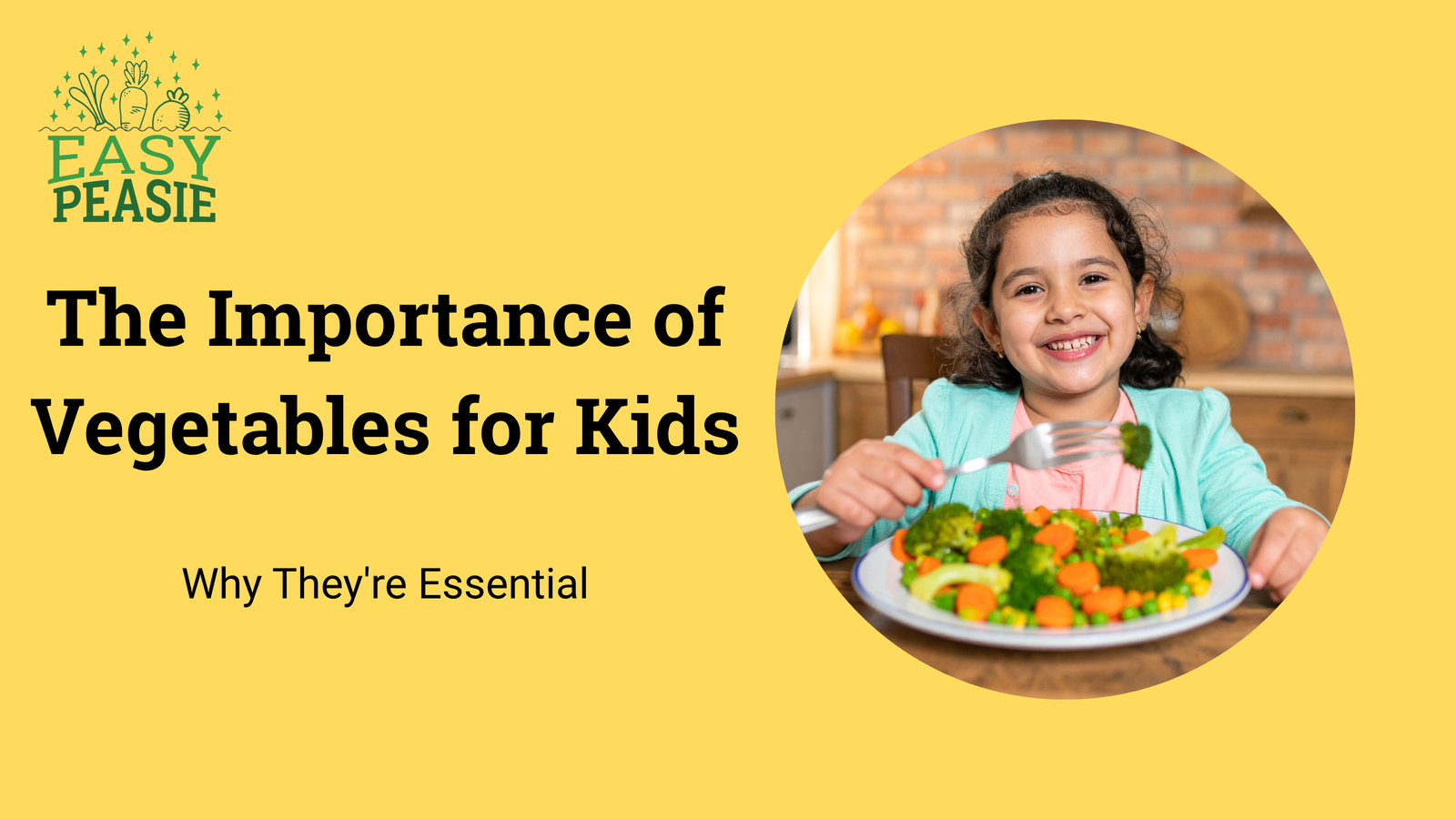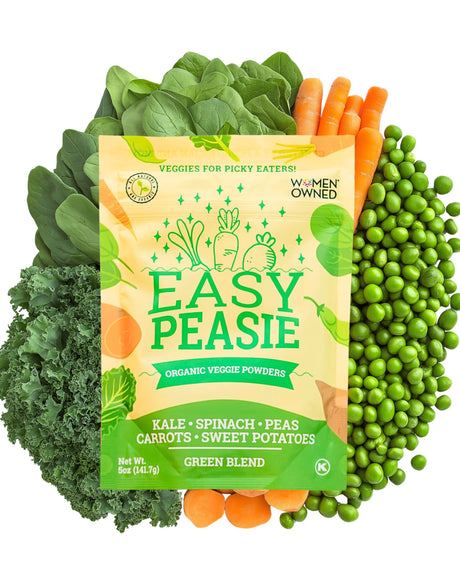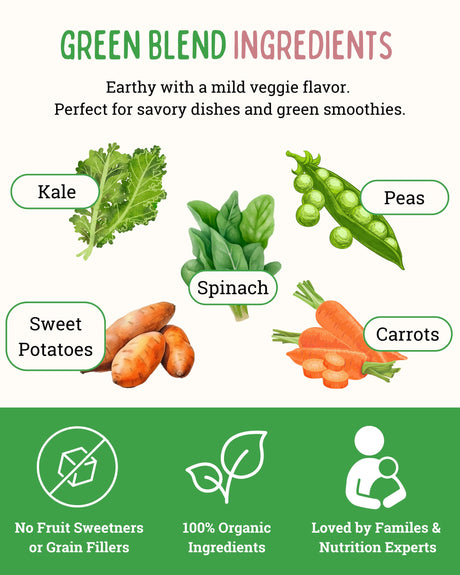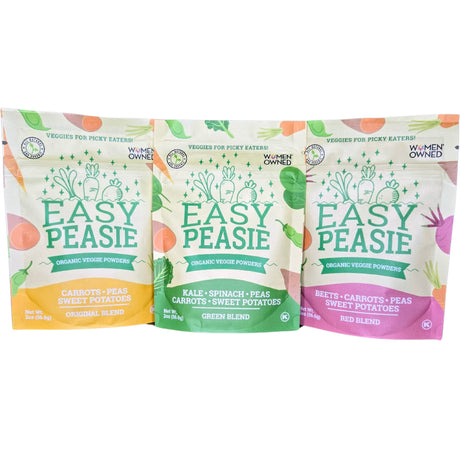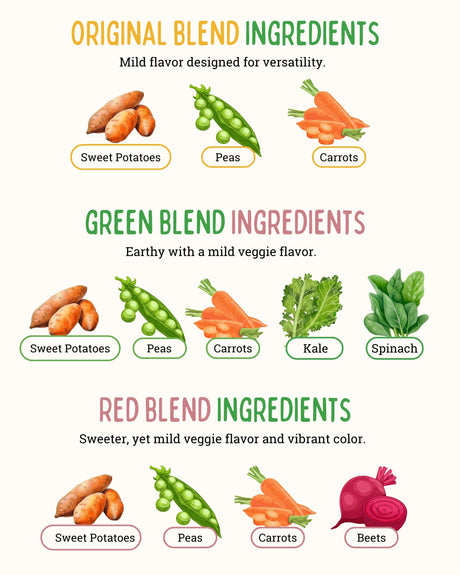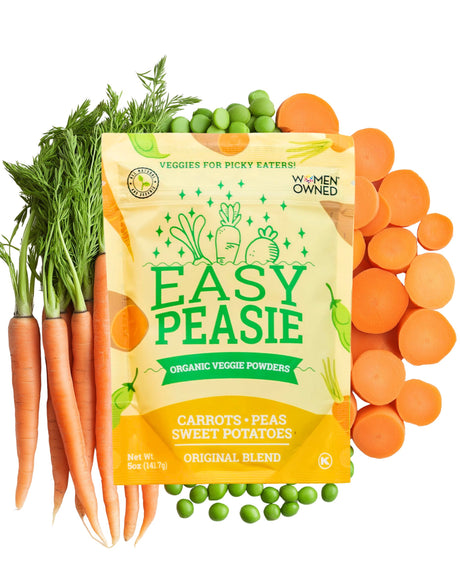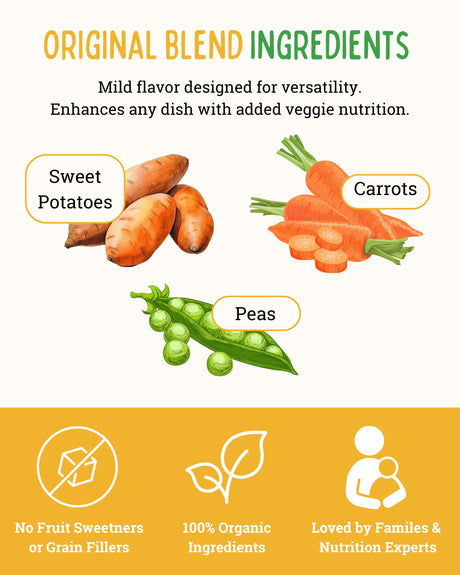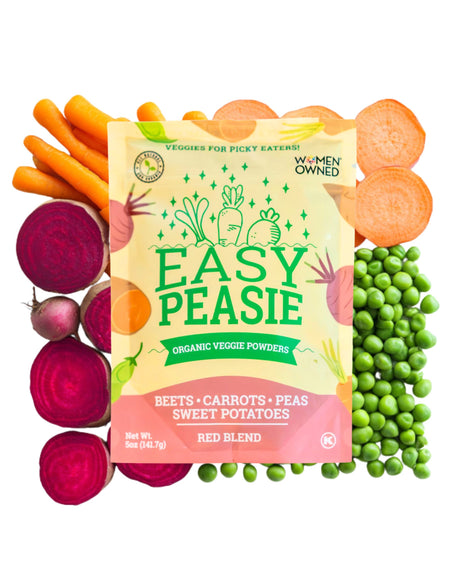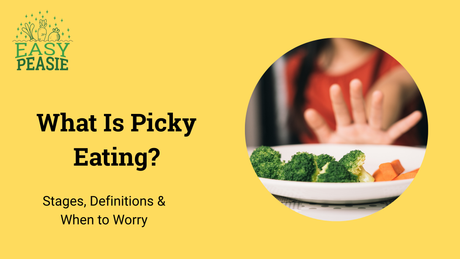The Importance of Vegetables for Kids
You're watching your child carefully pick around every green speck in their pasta sauce while you wonder if they'll ever get the nutrition they need to grow properly. Meanwhile, your pediatrician keeps emphasizing how important vegetables are for kids, leaving you feeling stressed about your child's limited diet.
If you're feeling overwhelmed by the constant advice to "get more vegetables into your child," you're definitely not alone. The truth is, vegetables really are incredibly important for growing children – but understanding why they matter so much and how to realistically incorporate them into your family's life can make all the difference.
Here's what we've learned from working with thousands of families: vegetables provide unique benefits that other foods simply can't replicate, but there are many creative and gentle ways to ensure your child gets these benefits, even if they're currently refusing anything green. The key is understanding what makes vegetables so special and then finding approaches that work with your child's preferences rather than against them.
Why Vegetables Are Uniquely Important for Growing Children
The Nutritional Powerhouse That Nothing Else Can Replace
Vegetables offer a combination of nutrients that simply can't be found together in any other food group. While you might be able to get individual vitamins from other sources, the unique package that vegetables provide – fiber, antioxidants, vitamins, minerals, and plant compounds working together – is irreplaceable.
For growing children, this nutritional synergy is especially important. Their bodies are developing rapidly, building everything from brain cells to bone structure, and vegetables provide many of the raw materials needed for healthy development.
What Makes Vegetables Special:
- High nutrient density with relatively few calories
- Unique combinations of vitamins and minerals
- Plant compounds that support immune function
- Fiber that promotes healthy digestion
- Antioxidants that protect developing cells
- Water content that supports hydration
Critical Nutrients Found Primarily in Vegetables
While a well-rounded diet includes many food groups, certain nutrients are found primarily or most abundantly in vegetables. For children, missing these nutrients can impact everything from energy levels to immune function to long-term health.
Essential Nutrients from Vegetables:
- Folate: Critical for brain development and cell division
- Vitamin K: Essential for bone health and blood clotting
- Potassium: Supports heart function and muscle development
- Vitamin A: Vital for vision, immune function, and cell growth
- Vitamin C: Necessary for immune support and iron absorption
- Fiber: Promotes digestive health and helps prevent constipation
The Fiber Factor: Why It Matters More Than You Think
Fiber deserves special attention because it's one of the most important nutrients that children typically don't get enough of, especially picky eaters. Fiber does much more than prevent constipation – it supports healthy gut bacteria, helps regulate blood sugar, and even influences mood and behavior.
Most children need 15-25 grams of fiber daily, but kids eating primarily processed foods often get less than half that amount. Since vegetables are one of the best sources of child-friendly fiber, missing them from the diet often leads to digestive issues that can actually make picky eating worse.
How Vegetables Support Child Development
Brain Development and Cognitive Function
The developing brain requires a constant supply of nutrients, and vegetables provide many compounds that specifically support brain health. The folate in leafy greens, the antioxidants in colorful vegetables, and the nitrates in beets all contribute to healthy brain development and function.
Research suggests that children who eat more vegetables tend to have better concentration, memory, and academic performance. While we can't say vegetables directly cause better grades, the nutritional support they provide creates a foundation for optimal brain function.
Immune System Support
Children's immune systems are still developing, making them more susceptible to illnesses. Vegetables provide vitamin C, beta-carotene, and other antioxidants that help strengthen immune defenses and support recovery from illness.
The variety of plant compounds in different colored vegetables also helps train the immune system to recognize and respond appropriately to various challenges. This is why eating a rainbow of vegetables is often recommended – each color provides different protective compounds.
Healthy Growth and Development
Growing children need adequate vitamins and minerals to support bone development, muscle growth, and overall physical development. Vegetables provide many of these nutrients in forms that are easily absorbed and utilized by developing bodies.
Key Growth-Supporting Nutrients from Vegetables:
- Vitamin K for strong bone development
- Folate for healthy cell division and growth
- Iron for energy and healthy blood
- Calcium from leafy greens for bone and teeth development
- Magnesium for muscle and nerve function
Establishing Lifelong Health Patterns
Perhaps most importantly, eating vegetables during childhood helps establish taste preferences and eating patterns that tend to persist into adulthood. Children who learn to enjoy vegetables are more likely to continue eating them as teens and adults, setting themselves up for better long-term health.
This doesn't mean children need to love every vegetable immediately, but regular exposure to vegetable flavors and positive associations with vegetable-containing meals create a foundation for lifelong healthy eating.
The Reality Check: What If Your Child Won't Eat Vegetables?
You're Not Failing as a Parent
If your child currently refuses most or all vegetables, this doesn't mean you're doing anything wrong. Many factors influence children's food preferences, including genetics, temperament, sensory sensitivities, and developmental stages.
Some children are naturally more adventurous eaters, while others are more cautious about new foods. Both approaches have evolutionary advantages, and neither makes a child "good" or "bad" at eating.
The Exposure vs. Consumption Distinction
Here's something that might surprise you: children can benefit from vegetables even when they're not actively eating them. Simply seeing, smelling, and being around vegetables helps familiarize children with these foods and increases the likelihood of eventual acceptance.
This means that continuing to include vegetables in family meals, even when your child ignores them, is still providing value. Each exposure counts toward building familiarity and comfort with vegetable foods.
Creative Solutions That Actually Work
When children won't eat whole vegetables, there are many ways to ensure they still get the important nutrients vegetables provide. The goal is supporting their nutrition while working toward eventual vegetable acceptance.
Practical Approaches:
- Vegetable purees mixed into familiar sauces
- Finely chopped vegetables incorporated into accepted foods
- Vegetable-based smoothies with sweet fruits
- Vegetable powders added to familiar meals
- Gradually increasing vegetable content in accepted dishes
Strategic Ways to Include Vegetable Nutrition
The Bridge Approach: Meeting Kids Where They Are
Rather than battling over whole vegetables, consider starting with approaches that provide vegetable nutrition in forms your child can accept. This reduces mealtime stress while ensuring they get essential nutrients.
Easy Peasie Veggie Powder Blends offer a perfect example of this approach. These powders contain real vegetables like carrots, peas, sweet potatoes, kale, spinach, and beets – providing the same nutrients as fresh vegetables but in a form that can be easily mixed into foods children already enjoy.
One parent shared: "My daughter is autistic and a VERY picky eater. If she could live off crackers, she would. She never notices when I put these veggies in her food and neither do I! I put it on her snacks and meals."
Building Positive Associations
The goal isn't just to get vegetables into your child, but to help them develop positive associations with vegetable-containing foods. This happens when children feel good after eating and don't experience pressure or stress around meals.
Creating Positive Experiences:
- Include small amounts of vegetables in foods they already love
- Let children help with simple food preparation when possible
- Focus on family enjoyment of meals rather than what anyone eats
- Celebrate small steps toward vegetable acceptance
- Maintain patience with the gradual process of taste development
The Variety Advantage
Different vegetables provide different nutrients, which is why variety matters. However, if your child will only accept one type of vegetable or vegetable preparation, that's still better than none at all.
Nutritional Variety from Different Vegetables:
- Orange vegetables (carrots, sweet potatoes) provide beta-carotene
- Leafy greens (spinach, kale) offer folate and iron
- Red vegetables (beets, red peppers) contain unique antioxidants
- Cruciferous vegetables (broccoli, cauliflower) provide sulfur compounds
- Purple vegetables (purple cabbage, eggplant) offer anthocyanins
Easy Peasie blends are specifically designed to provide this variety. The Original Blend combines carrots, peas, and sweet potatoes, while the Green Blend adds kale and spinach, and the Red Blend includes beets for additional nutritional diversity.
Vegetables & Their Key Nutrients
Essential nutrition for growing children
- Beta-carotene: Vision & immune health
- Fiber: Digestive support
- Potassium: Heart & muscle function
- Beta-carotene: Eye health & immunity
- Vitamin C: Immune support
- Fiber: Blood sugar balance
- Folate: Brain development
- Iron: Energy & healthy blood
- Vitamin K: Bone health
- Vitamin K: Strong bones
- Vitamin C: Immune function
- Folate: Cell development
- Protein: Growth & development
- Fiber: Digestive health
- Vitamin C: Immune support
- Vitamin C: Antioxidant protection
- Folate: Brain development
- Fiber: Digestive support
- Nitrates: Blood flow & brain function
- Folate: Cell development
- Fiber: Digestive health
- Vitamin C: High antioxidants
- Beta-carotene: Eye health
- Folate: Neural development
Addressing Common Concerns About Vegetable Nutrition
"Is Vegetable Powder as Good as Fresh Vegetables?"
This is one of the most common questions from parents using vegetable powders or purees. The truth is that vegetable powders made from real vegetables retain most of their nutritional value – the vitamins, minerals, fiber, and plant compounds are concentrated rather than eliminated.
While fresh vegetables offer benefits like teaching children to recognize different textures and flavors, vegetable powders can provide essential nutrition when fresh vegetables are being refused. Think of them as nutritional insurance while you continue working toward fresh vegetable acceptance.
"How Much is Enough?"
The ideal amount of vegetables for children varies by age, but most children need 1-3 cups of vegetables daily. However, if your child is currently eating no vegetables, any amount represents progress.
Two tablespoons of quality vegetable powder can provide nutrients equivalent to about one cup of fresh vegetables, making it an efficient way to meet nutritional needs when fresh vegetable consumption is limited.
"What About Vitamins vs. Whole Food Sources?"
While vitamin supplements can address specific deficiencies, they don't provide the full spectrum of compounds found in whole vegetables. Vegetables contain hundreds of beneficial compounds that work together synergistically – something that can't be replicated in a vitamin pill.
Vegetable powders made from whole vegetables offer a middle ground, providing the complete nutritional profile of vegetables in a concentrated form that's often more acceptable to picky eaters than fresh vegetables.
Making Vegetables Work for Your Family
Start Where Your Child Is
The most effective approach to increasing vegetable intake is to start with your child's current preferences and gradually expand from there. This might mean adding tiny amounts of vegetable puree to pasta sauce or mixing vegetable powder into mac and cheese.
Success builds on success, so starting with approaches that work creates positive momentum rather than mealtime battles.
Focus on Addition, Not Restriction
Rather than focusing on what your child isn't eating, concentrate on what you can add to their accepted foods. This positive approach reduces stress for everyone and often leads to better outcomes than battles over whole vegetables.
Addition Strategies:
- Add vegetable powder to familiar smoothies
- Mix pureed vegetables into tomato sauce
- Include finely grated vegetables in meatballs or meatloaf
- Blend vegetables into soups your child already enjoys
- Use vegetable-based alternatives for familiar foods
Maintain Long-Term Perspective
Developing vegetable acceptance is typically a gradual process that unfolds over months or years rather than days or weeks. Maintaining realistic expectations helps reduce stress and creates space for natural development of food preferences.
Many parents find that as their children get the nutrition they need through creative approaches, they become more willing to try whole vegetables because they're not carrying the weight of the family's nutritional anxiety.
The Whole Family Benefits
Modeling Matters
Children learn more from watching their parents than from any nutrition lecture. When families focus on including vegetable nutrition in meals everyone can enjoy, it creates opportunities for positive modeling without pressure.
Eating vegetables yourself and expressing genuine enjoyment helps children see vegetables as normal, desirable foods rather than medicine they're being forced to take.
Reducing Mealtime Stress
When parents feel confident that their children are getting essential vegetable nutrition, it often reduces the stress and battles around fresh vegetables. This calmer mealtime atmosphere actually makes children more likely to try new foods, including vegetables.
Creating Food-Positive Families
Families that find successful ways to include vegetable nutrition often develop more positive relationships with food overall. Children learn that nutrition can be achieved in various ways, and parents feel empowered rather than frustrated around feeding.
Practical Implementation for Busy Families
Week One: Assessment and Planning
Start by honestly assessing your child's current vegetable intake and identifying accepted foods that could be enhanced with vegetable nutrition. Don't try to change everything at once.
Week Two: Gentle Introduction
Begin adding vegetable nutrition to one accepted food, starting with small amounts. Continue offering fresh vegetables alongside meals without pressure, but don't make acceptance a battle.
Week Three: Building Consistency
Establish routines around including vegetable nutrition in your family's meals. This might mean adding vegetable powder to morning smoothies or mixing pureed vegetables into weekly pasta dinners.
Long-Term Success
Continue providing vegetable nutrition through accepted methods while maintaining gentle exposure to whole vegetables. Celebrate small steps toward vegetable acceptance while ensuring nutritional needs are consistently met.
Moving Forward with Confidence
Trust the Process
Helping children develop appreciation for vegetables is a marathon, not a sprint. The vegetable nutrition they receive today supports their current growth and development while you work toward long-term food acceptance.
Celebrate Progress
Whether your child takes a tiny bite of a fresh vegetable or simply allows vegetable powder in their favorite food without complaint, every step represents progress worth celebrating.
Remember the Big Picture
The goal isn't perfect vegetable consumption – it's raising healthy, well-nourished children who have positive relationships with food. There are many ways to achieve this goal, and finding approaches that work for your specific family is more important than following someone else's ideal plan.
Vegetables truly are important for children's health and development, providing unique nutritional benefits that support everything from brain development to immune function. However, there are many creative and gentle ways to ensure children receive these benefits, even when they're not ready to embrace whole vegetables.
Remember that every family's journey with vegetables looks different, and what matters most is finding sustainable ways to support your child's health and development while maintaining positive mealtime experiences for everyone.
Disclaimer: This article is for educational purposes only and does not constitute medical advice. Always consult with your child's healthcare provider for concerns about nutrition, growth, or development.

